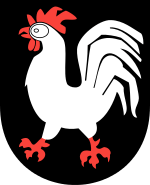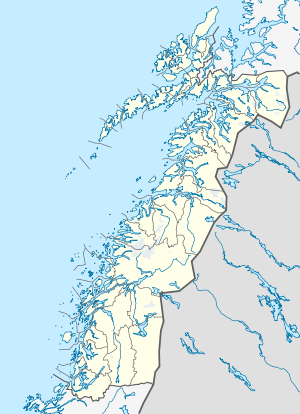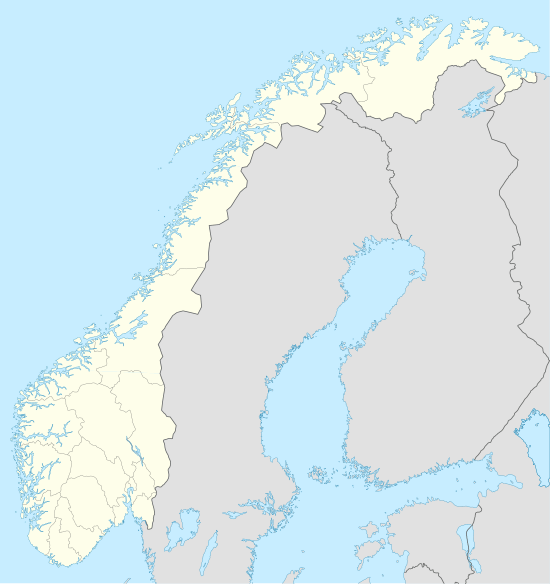Mosjøen
| Mosjøen Mussere | |
|---|---|
| Town | |
 | |
 Mosjøen  Mosjøen | |
| Coordinates: 65°50′N 13°12′E / 65.833°N 13.200°ECoordinates: 65°50′N 13°12′E / 65.833°N 13.200°E | |
| Country | Norway |
| County | Nordland |
| Municipality | Vefsn |
| Area[1] | |
| • Total | 6.41 km2 (2.47 sq mi) |
| Population (2013)[1] | |
| • Total | 9,665 |
| • Density | 1,508/km2 (3,910/sq mi) |
| Time zone | UTC+01:00 (CET) |
| • Summer (DST) | UTC+02:00 (CEST) |
Mosjøen (Norwegian pronunciation: [ˈmuːʃøn] ![]()
Together with Mo i Rana and Narvik, Mosjøen is one of the industrial towns in Nordland. Owned by Alcoa, Mosjøen Aluminum Plant is among the biggest in Europe, and is traditionally the town's cornerstone. Additionally, the town's business sector includes trade, crafts, banking, transportation, and tourism. The town attracts customers from the entire region.
Mosjøen is a transport hub in Helgeland. From Mosjøen, it is 71 kilometres (44 miles) to Sandnessjøen in the west, 87 kilometres (54 miles) to Mo i Rana in the north, and 160 kilometres (99 miles) to Brønnøysund in the south. Furthermore, the road distance is 318 km (198 miles) to Bodø and 393 km (244 miles) to Trondheim. The E6 runs through the town. There are daily departures from Mosjøen Bus Central, from Mosjøen Railway Station on the Nordland Line, and from Mosjøen Airport south of the town. There are both public and private quays in Mosjøen. The town's harbour is among the largest in Northern Norway.
In the aspect of secondary and adult education, Mosjøen exercises both local and regional functions. Offering general (including music), vocational, and agricultural lines, Mosjøen High School also receives students from rural municipalities surrounding the town and from other regions of Nordland. Vefsn Folk High School lies in Mosjøen, while Sandvik Folk High School is located north of it. The town has got a department of the Open University. Many bigger events for children and youths take place in Mosjøen, among others Toppen International Summer Music School and The Kippermoen Cup.
Mosjøen is known for Sjøgata: Northern Norway's longest cluster of 19th-century wooden houses and piers. Other tourist attractions include Dolstad Church from 1735, the award-winning Town Park from 1905, and the aluminum plant.
Etymology

Historically located in the outskirts of a large and central farm called Mo, from which the town has got its name, Mosjøen means 'the sea(side) belonging to Mo'. In other words, it was a place where the Mo farmers had their boats and boatsheds. Descending from Old Norwegian mór, Mo translates as moorland. Earlier spellings are Mosøen in the 19th century and Moesøen in the 18th.
Mosjøen's coat of arms was granted by King Olav V on 25 March 1960. Composed by sculptor Arthur Gustavsson, it is blazoned Sable, a cock Argent. The cock is traditionally equipped with red beak, wattles, comb, and claws: the so-called colour of armament. The cock represents watchfulness and fighting spirit.
History



Mentioned in Aslak Bolt's cadastre of the 15th century, Mo is a medieval farm with a history at least dating to the Viking Age. Mosjøen's own history starts in the early modern period. Mosjøen was populated by 1600.[2] The earliest inhabitant known by name is Svein Beachdweller, who lived there together with his wife and daughters in 1660.[2] In the 17th and early 18th century, especially following the 1645 Treaty of Brömsebro, several inhabitants of Jemtland escaped to Trøndelag and to Nordland. Many of them came to Vefsn, including Mosjøen. In the 18th century, Mosjøen as a settlement for nonagrarian occupations started to materialise. For example, the regional executioner resided there temporarily. As did a handful of craftsmen and public officials.
From the late 16th century until the 1820s, Mo was possessed by the Mo family: wealthy farmers as well as skippers and merchants who contributed to Mosjøen's gradual expansion. In 1794, a member of the family received royal privilege to establish a trading post in Mosjøen.
In the 1860s, a group of Englishmen—the 'salmon lords'—established The North of Europe Land & Mining Company, introducing the first industrial period in Mosjøen. Sawmill industry created 'Klondike conditions': People came from everywhere in order to get a job, to trade, and so on, and salaries were relatively high. A rapidly growing town, Mosjøen received staple rights on 1 January 1875, and was demerged from Vefsn as a municipality on 1 January 1876. These privileges were granted by King Oscar II on 4 April 1874. A staple place, Mosjøen now had the privilege to export goods directly to foreign countries.
The biggest and most important and central town in the Helgeland region, Mosjøen became headquarters of the Nazi German occupiers between 1940 and 1945.
In 1945, Mosjøen entered its second industrial period. Among several industrial establishments was Mosjøen Aluminum Plant.
Mosjøen was again merged with Vefsn on 1 January 1962. In 1998, Mosjøen adopted formal status as a town.
Industry and business

Mosjøen is one of the industrial towns in Nordland. Especially important is the Mosjøen Aluminum Plant, owned by Alcoa.
Mosjøen's business sector contains both traditional and modern companies as well as a wide spectre of branches, including trade, crafts, banking, transportation, and tourism. The town is a commercial centre in the region, attracting customers from smaller neighbouring towns and from rural municipalities.
Communications

A transport hub in Helgeland, Mosjøen connects Sandnessjøen 71 kilometres (44 miles) to the west, Mo i Rana 87 kilometres (54 miles) to the north, and Brønnøysund 160 kilometres (99 miles) to the south by road. The European route E6 between Trondheim 393 kilometres (244 miles) to the south and the county capital Bodø 318 kilometres (198 miles) to the north runs through Mosjøen.
Mosjøen is also accessible by airplane, by train, and by ship. Mosjøen is served by Mosjøen Airport, Kjærstad, which is located five minutes by car south of the town. Mosjøen Station on the Nordland Line has daily departures for Trondheim in the south and for the Bodø in the north. A smaller commuter rail operates between Trofors and Mo i Rana.
Encompassing both private and public quays, Mosjøen's harbour is the biggest port in Northern Norway. Mosjøen Aluminum Plant has got its own port.
Tourism

The following are popular sightseeing spots:
- Sjøgata, a historic and picturesque street containing the largest concentration of 19th-century wooden buildings in Northern Norway.
- Fru Haugans Hotel, established in 1794 and today the oldest hotel in Northern Norway.
- Dolstad Church, established in 1735.
- The Town Park, established ca. 1900 and regarded as one of the finest public parks in Norway.
Geography
Topography
Mosjøen is situated in the lower part of the Vefsn Valley, where the Vefsna and Skjerva rivers flow into the Vefsnfjord. Downtown Mosjøen lies on a flat moorland between said rivers. Moreover, the town is surrounded by mountains and hills, which are mainly vegetated. Standing immediately west of the town, the 814-metre-tall Øyfjellet dominates the town's landscape.
Climate
Mosjøen is located about 100 kilometres (62 mi) south of the Arctic circle, and the town has a wet and mild subarctic climate (Köppen: Dfc). The town has mild summers and moderately cold winters, but is mild compared to other places on similar latitudes. Situated at the head of a relatively narrow fjord, Mosjøen is not as mild in winter as places on the outer seaboard, but has slightly warmer summers. Mosjøen receives a large amount of precipitation, particularly in autumn and early winter. Its temperatures are fairly similar to that of Anchorage, Alaska.
| Climate data for Mosjøen 1961-90 (recent decades have been warmer) | |||||||||||||
|---|---|---|---|---|---|---|---|---|---|---|---|---|---|
| Month | Jan | Feb | Mar | Apr | May | Jun | Jul | Aug | Sep | Oct | Nov | Dec | Year |
| Average high °C (°F) | −5 (23) |
−4 (25) |
0 (32) |
5 (41) |
10 (50) |
13 (55) |
18 (64) |
17 (63) |
12 (54) |
7 (45) |
−3 (27) |
−6 (21) |
5 (42) |
| Daily mean °C (°F) | −5.7 (21.7) |
−4.5 (23.9) |
−1.6 (29.1) |
2.4 (36.3) |
7.6 (45.7) |
11.6 (52.9) |
13.4 (56.1) |
12.8 (55) |
8.6 (47.5) |
4.6 (40.3) |
−1.4 (29.5) |
−4.2 (24.4) |
3.6 (38.5) |
| Average low °C (°F) | −9 (16) |
−10 (14) |
−8 (18) |
0 (32) |
4 (39) |
7 (45) |
12 (54) |
10 (50) |
5 (41) |
2 (36) |
−7 (19) |
−10 (14) |
0 (32) |
| Average precipitation mm (inches) | 186 (7.32) |
135 (5.31) |
150 (5.91) |
99 (3.9) |
79 (3.11) |
80 (3.15) |
100 (3.94) |
116 (4.57) |
191 (7.52) |
230 (9.06) |
181 (7.13) |
198 (7.8) |
1,745 (68.72) |
| Source: [3][4] | |||||||||||||
Friendship towns
| Town | Country | Start | Reason |
|---|---|---|---|
| 1965[5] | Old trade connections. Besides, Lycksele was first in Lapland to become a town.[6] | ||
| 28 Sep 1975 | During WW2, at least 425 Serbian prisoners at Osen Camp, Vefsn, were killed.[6] | ||
| 16 Jun 1992 | Established in 1932, Kirov was Russia's first aluminum plant.[6] |
References
- 1 2 3 Statistisk sentralbyrå (1 January 2013). "Urban settlements. Population and area, by municipality".
- 1 2 Jæger, Claes-Henrik: Mosjøen i Norges Bebyggelse : Fylkesbindet for Sør-Trøndelag, Nord-Trøndelag og Nordland fylker, p. 725–732. Norsk Yrkesforlag, 1954.
- ↑ "Mosjøen average conditions - base period 10 last years". Storm Weather Center. Retrieved 3 March 2011.
- ↑ "Normaler for Vefsn kommune (1961-1990)". Meterologisk institutt. Archived from the original on 4 April 2011. Retrieved 3 March 2011.
- ↑ Municipality of Lycksele: Our Twin Municipalities Archived 2016-03-03 at the Wayback Machine.
- 1 2 3 Municipality of Vefsn: Vennskapskommuner
Links to external websites
| Wikimedia Commons has media related to Mosjøen. |
- Municipality of Vefsn
- Mosjøen.com
- Vefsn Slektshistorielag (Genealogy)